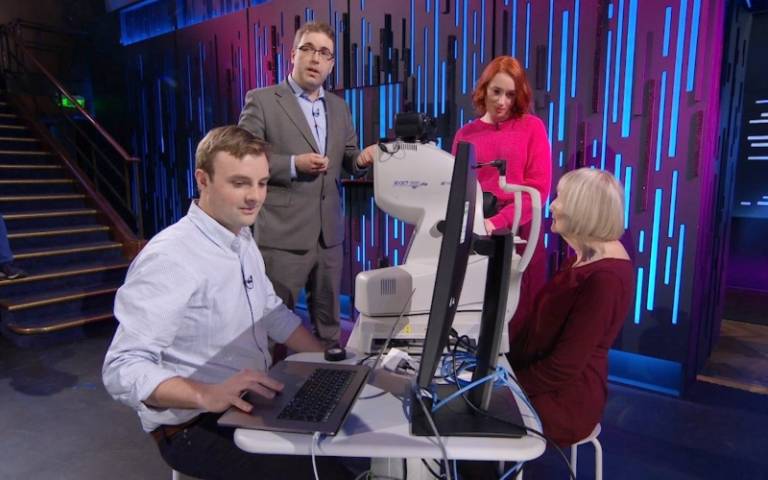IoO Associate Professor Pearse Keane features in Royal Institution Christmas Lecture
10 January 2020
The lecture was the second of ‘The Hidden Power of Maths’ series. Entitled ‘How to Bend the Rules’, it focussed on algorithmic learning and was broadcast on 27 December 2019 on BBC Four.

This year’s Royal Institution Christmas lecturer, Dr Hannah Fry from UCL’s Centre for Advanced Spatial Analysis, invited Dr Keane to talk about his pioneering development of algorithms to help speed up the detection of retinal disease.
Dr Keane is a consultant ophthalmologist at Moorfields Eye hospital, as well as an Associate Professor at UCL, and specialises in the treatment of retinal diseases – in particular, age-related macular degeneration (AMD), the commonest cause of blindness in the UK.
AMD can be treated if picked up early, which can prevent people from going blind. However, with as many as 200 people developing blinding forms of AMD every day, it can be challenge to detect and treat it in time.
Beginning in 2016, Dr Keane identified an opportunity to use AI in the detection of the early signs of AMD through optical coherence tomography (OCT) and began the process of applying novel deep-learning architecture to a set of 3D OCT scans from patients referred to Moorfields.
During the lecture, Dr Keane introduced the audience to Elaine, one of his Moorfields patients, to demonstrate the technique using a sophisticated 3D scanner to produce an image of the back of the eye at super high resolution. The algorithm developed by Dr Keane and his team processed the results, which in Elaine’s case allowed it to pick up almost instantly that she had a problem requiring urgent treatment. The computer was able to recognise Choroidal neovascularization, or blood vessel growth at the back of the eye, which is suggestive of AMD.
In an article published in Nature in August 2018, Dr Keane and his colleagues were able to show proof of concept that the algorithm they had developed was as good at diagnosing AMD as consultants at Moorfields and other world-leading experts.
The technology is particularly important in diagnosing urgent cases more quickly. Instead of having to wait several weeks to see a consultant, Elaine was able to get the treatment that she needed in time to save her good eye.
The research illustrates how the AI technology can allow computers to interpret complex medical imaging and give incredibly quick diagnosis as accurately as human experts, opening up the possibility of diagnosing many other kinds of diseases using AI.
Speaking about his TV appearance, Dr Keane said:
Taking part in the Royal Institution Christmas Lectures was really exciting for me. It was both thrilling and nerve-wracking to perform a demonstration of our AI system in front of a live audience! I was also able to bring my family, including my two young daughters, to the dress rehearsal beforehand, which made the event really special.““Taking part in the Royal Institution Christmas Lectures was really exciting for me. It was both thrilling and nerve-wracking to perform a demonstration of our AI system in front of a live audience! I was also able to bring my family, including my two young daughters, to the dress rehearsal beforehand which made the event really special” “Taking part in the Royal Institution Christmas Lectures was really exciting for me. It was both thrilling and nerve-wracking to perform a demonstration of our AI system in front of a live audience! I was also able to bring my family, including my two young daughters, to the dress rehearsal beforehand which made the event really special”
Further information
- View the second Royal Institution Christmas Lecture on BBC iPlayer (available until 26 January 2020). Watch from 46 minutes
- Read more about the Royal Institution Christmas Lectures
- See the original research published in Nature Medicine
- See Dr Pearse Keane's academic profile
- Visit the Moorfields Eye Hospital website
 Close
Close

